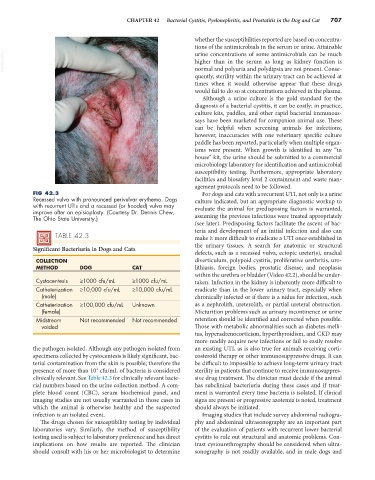Page 735 - Small Animal Internal Medicine, 6th Edition
P. 735
CHAPTER 42 Bacterial Cystitis, Pyelonephritis, and Prostatitis in the Dog and Cat 707
whether the susceptibilities reported are based on concentra-
tions of the antimicrobials in the serum or urine. Attainable
VetBooks.ir urine concentrations of some antimicrobials can be much
higher than in the serum as long as kidney function is
normal and polyuria and polydipsia are not present. Conse-
quently, sterility within the urinary tract can be achieved at
times when it would otherwise appear that these drugs
would fail to do so at concentrations achieved in the plasma.
Although a urine culture is the gold standard for the
diagnosis of a bacterial cystitis, it can be costly; in practice,
culture kits, paddles, and other rapid bacterial immunoas-
says have been marketed for companion animal use. These
can be helpful when screening animals for infections;
however, inaccuracies with one veterinary specific culture
paddle has been reported, particularly when multiple organ-
isms were present. When growth is identified in any “in
house” kit, the urine should be submitted to a commercial
microbiology laboratory for identification and antimicrobial
susceptibility testing. Furthermore, appropriate laboratory
facilities and biosafety level 2 containment and waste man-
agement protocols need to be followed.
FIG 42.3 For dogs and cats with a recurrent UTI, not only is a urine
Recessed vulva with pronounced perivulvar erythema. Dogs culture indicated, but an appropriate diagnostic workup to
with recurrent UTIs and a recessed (or hooded) vulva may evaluate the animal for predisposing factors is warranted,
improve after an episioplasty. (Courtesy Dr. Dennis Chew,
The Ohio State University.) assuming the previous infections were treated appropriately
(see later). Predisposing factors facilitate the ascent of bac-
teria and development of an initial infection and also can
TABLE 42.3 make it more difficult to eradicate a UTI once established in
Significant Bacteriuria in Dogs and Cats the urinary tissues. A search for anatomic or structural
defects, such as a recessed vulva, ectopic ureter(s), urachal
COLLECTION diverticulum, polypoid cystitis, proliferative urethritis, uro-
METHOD DOG CAT lithiasis, foreign bodies, prostatic disease, and neoplasia
within the urethra or bladder (Video 42.2), should be under-
Cystocentesis ≥1000 cfu/mL ≥1000 cfu/mL taken. Infection in the kidney is inherently more difficult to
Catheterization ≥10,000 cfu/mL ≥10,000 cfu/mL eradicate than in the lower urinary tract, especially when
(male) chronically infected or if there is a nidus for infection, such
Catheterization ≥100,000 cfu/mL Unknown as a nephrolith, ureterolith, or partial ureteral obstruction.
(female) Micturition problems such as urinary incontinence or urine
Midstream Not recommended Not recommended retention should be identified and corrected when possible.
voided Those with metabolic abnormalities such as diabetes melli-
tus, hyperadrenocorticism, hyperthyroidism, and CKD may
more readily acquire new infections or fail to easily resolve
the pathogen isolated. Although any pathogen isolated from an existing UTI, as is also true for animals receiving corti-
specimens collected by cystocentesis is likely significant, bac- costeroid therapy or other immunosuppressive drugs. It can
terial contamination from the skin is possible; therefore the be difficult to impossible to achieve long-term urinary tract
presence of more than 10 cfu/mL of bacteria is considered sterility in patients that continue to receive immunosuppres-
3
clinically relevant. See Table 42.3 for clinically relevant bacte- sive drug treatment. The clinician must decide if the animal
rial numbers based on the urine collection method. A com- has subclinical bacteriuria during these cases and if treat-
plete blood count (CBC), serum biochemical panel, and ment is warranted every time bacteria is isolated. If clinical
imaging studies are not usually warranted in those cases in signs are present or progressive azotemia is noted, treatment
which the animal is otherwise healthy and the suspected should always be initiated.
infection is an isolated event. Imaging studies that include survey abdominal radiogra-
The drugs chosen for susceptibility testing by individual phy and abdominal ultrasonography are an important part
laboratories vary. Similarly, the method of susceptibility of the evaluation of patients with recurrent lower bacterial
testing used is subject to laboratory preference and has direct cystitis to rule out structural and anatomic problems. Con-
implications on how results are reported. The clinician trast cystourethrography should be considered when ultra-
should consult with his or her microbiologist to determine sonography is not readily available, and in male dogs and

